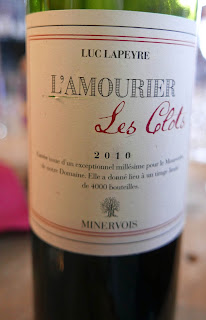Sarabande's GSM. Where Syrah dances on a windy hill
And partners well with Grenache and Mourvedre.
 |
| Isla and Paul, when I met them in Cork |
The Syrah for the wines below is trellised across the top of a windy hill in the Languedoc that was planted with the aid of dynamite. The earth is completely made up of classic blue/grey schist with practically no topsoil. Therefore the rock had to be blown up so that the vines could find some dirt where they could anchor.
Despite these kind of local obstacles, there are more vines growing in the Languedoc than in Australia. Paul Gordon should know. He is Australian and he and his Carlow wife Isla work (and I mean work) the Sarabande vineyard, about twenty minutes drive from Beziers. The rugby-loving couple’s vineyard is called Domaine la Sarabande.
They met in New Zealand in 2003 and then spent five or six years in wine in Marlborough. In 2009, they settled in France and raised some €40,000 from relations and friends in return for wine in the future. Isla: “There is just the two of us. We are very small; everything is gently worked and done by hand..”
With so many vineyards in the area, there is much competition locally and so the pair export most of their wine, mainly to English speaking countries. And indeed, those same countries (Ireland, US, Australia and New Zealand) are all happy with the Sarabande screw caps but not so the French.
Today, working with some unique terroirs and old vineyards treated organically and by hand, the Gordons, according to their importers O’Brien’s, “produce some stunningly good old world wines but with a modern Oz twang”.
Sarabande “Les Rabasses” Faugeres (AP) 2014, 14.5%, €21.45 (got it for 17.16 in sale) O’Brien’s
The aromas of the Faugeres are dominated by black cherries and plums as is this blend. The Syrah, on its exploded base, is trellised across the top of the windy hill. Unlike the Syrah (the dominant grape - about 50% - in this GSM blend), the Grenache and Mourvedre are grown as bush vines. They sit on a south facing slope which is well drained. This is particularly important for the notoriously late ripening Mourvedre variety.
And so it is from this hilltop vineyard that this Les Rabasses comes with its hard-won flavours. Keep it, they say, or drink it now with “equally flavoursome food”. Suggested are: Cold meats/pâtés, Duck, Hard mature cheese, Roast lamb/beef, Slow cooked shoulder of lamb.
Colour is a mid to dark ruby. There are strong aromas of dark fruit, spicy. Fruit forward and deep, power and finesse in equal measure, that spice too, excellent acidity as well; the finish is pure, long and also balanced. Very Highly Recommended.
Sarabande tell us that “bright cherry flavours are the backbone of this cheeky little number…that will invite itself.” Indeed, it is mainly cherry all the way from the colour to the aromas to the dry finalé. A slash of spice too, fine tannins and well balanced acidity add to the easy-drinking enjoyment. Highly Recommended.
The blend this time is mostly Grenache and Syrah with “a small amount of Mourvedre.” Only the best quality fruit survives the sorting stage.









